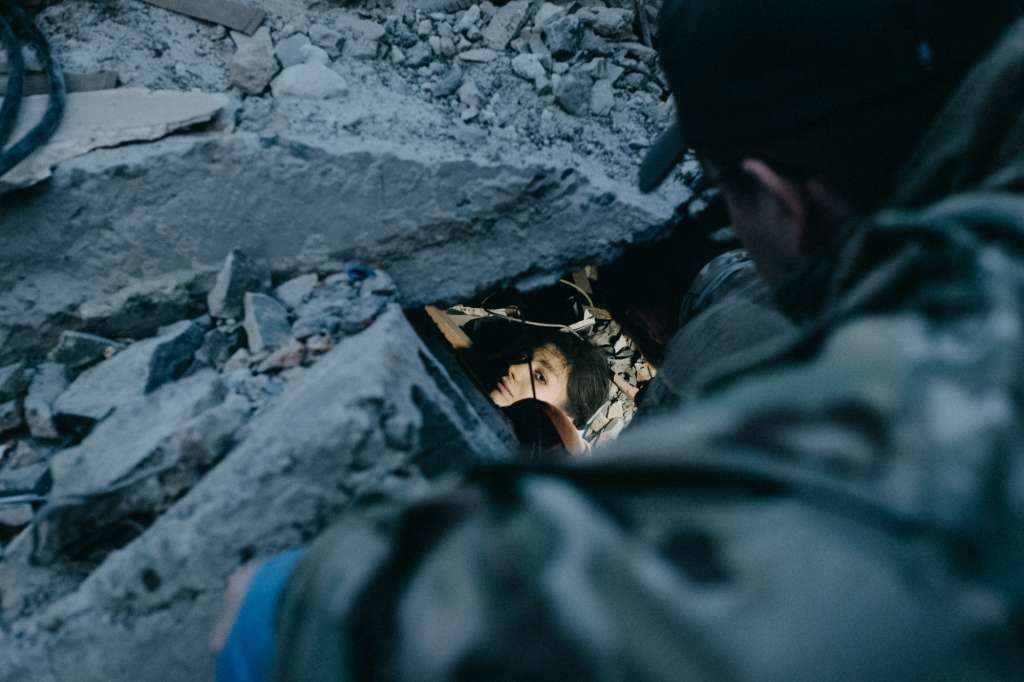Here is the war - an exhibition of photographs by Wojtek Grzędziński with texts by Pawel Reszka

Leica Store & Gallery Warsaw, 3 Mysia St., 3rd floor / vernissage: 17.07.18.00 / Exhibition: 18.07-17.08.2024 / Author's meeting: 18.07.202, at 18.00 / Curator's tour 20.07.2024, at 12.00 / Organizer: Leica Store & Gallery Warsaw / Curator: Monika Szewczyk-Wittek / Tickets: PLN 15 and 10 (concessionary) / Ticket proceeds will be donated to the Polish Medical Mission.
The war had been smoldering for a long time. First Russia, making a mockery of the law, took Crimea by force. Then its saboteurs launched a bloody rebellion in the Donbass. In eastern Ukraine - for nearly a decade - the shots have not fallen silent. However, few believed that Moscow would attack with full force. It was seemingly said by important politicians, "Putin is ready!" Supposedly one heard about it on TV shows: "Concentration of Russian troops on the border." And every Ukrainian family had a packed suitcase (money, documents, warm clothes) "just in case." So everyone was ready, it's just that they didn't fit in. Tanks advancing on Kiev? Bombs falling on cities? Burning hospitals, schools? How so, after all, we are in Europe! We are in the 21st century! Russia, however, has attacked. Every day people die under bombs, hundreds of wounded civilians are taken to hospitals and morgues. Ukraine is defending itself and suffering. This exhibition tells the story of a war that has become part of everyday life.
Pawel Reszka

Leica Store & Gallery Warsaw invites you to an exhibition of photographs by prominent Polish photojournalist Wojtek Grzędzinski.
It will be a story about the ongoing war in Ukraine from the moment it began, i.e. from the Revolution of Dignity in 2013, through the annexation of Crimea and the conflict with Russian-backed separatists, to the present. The main emphasis, however, is on the events that began to unfold after February 24, 2022, the full-scale aggression of the Russian Federation. The photographs are accompanied by texts by Pawel Reszka, a well-known journalist, columnist and war correspondent. Both authors have been documenting the conflict in Ukraine for years What will we see at the exhibition? In addition to Wojtek Grzędzinski's well-known photographs, the exhibition will feature author's previously unpublished photo series and stories written by Pawel Reszka, which complement and expand the picture of the conflict, rejecting stereotypical thinking about what war is. For this war is the first of its kind in world history, where modern technology intersects on the battlefield with weapons manufactured during World War II. Its size and the scale of the tragedy it caused are unimaginable. Grzędzinski's photographs and Reszko's texts focus on the aspect of wartime everyday life, showing events on the front line as well as far beyond it, always having the ordinary man at the center of the story. They document the war through the prism of history and the dramas of individual people for whom the aggression of the Russian Federation turned the world they knew upside down. Their stories are moving and stay in the memory for a long time. The story of Alina Boyko from the village of Dovhenke, who, like 540 other residents, fled the war, leaving all her belongings behind. When she returned after six months of fighting, not a single house remained untouched. Almost a year after liberation, Alina and her husband are still living in heavily mined areas without water or electricity.
And then there's the story of Oleksandra Ryazantseva, 40, nicknamed Yalta, who joined the Ukrainian Army on February 24, 2022, swapping a career as a top film stylist for "thirty-three shades of green," all in camouflage colors. A tattoo near her eye reminds her of the date in 2014 when she was taken prisoner during the beginning of the conflict. There are dozens of such stories in the exhibition.

However, the Here is War exhibition is not only photographs. It is also films, maps, press publications and a multimedia presentation. All reporter texts and captions have been translated into English and Ukrainian. The exhibition will be accompanied by additional events: a curator's tour, an author's meeting combined with a slide show, and coverage on social networks and digital media.

Wojtek Grzędziński - photojournalist. Born in 1980, in Warsaw. Winner of numerous competitions
Photography Awards; World Press Photo, Visa D'Or, NAPA, Sony World Photography Awards,
Grand Press Photo and others. Author of photo of the year 2009 and photo of the decade (2014) in the competition
BZWBK Press Photo. Juror of national and local photo contests. W
photography is interested in human beings and emotions. He has photographed many times in areas
armed conflicts and the consequences of wars. From 2011 to 2015, head of the team of photographers
In the Office of the President of the Republic of Poland and personal photographer of the President of the Republic of Poland. Scholarship holder of the Minister of Culture
and National Heritage for 2014 and 2018. member of the Union of Polish Artists
Photographers and Press Club Poland. He has been documenting the war in Ukraine since February 2022.
Pawel Reszka - Journalist, war correspondent (including in Georgia and Ukraine), author of
bestselling books. He has worked with "Rzeczpospolita" as a correspondent in Moscow,
He was head of the investigative section of the Journal. He wrote for "Tygodnik Powszechny" and
"Newsweek Poland." Since 2019, he has been a journalist for Polityka weekly. His
The most famous books include Small Gods. On the anesthesia of Polish doctors, Greed. How
We are being cheated by big companies, Black. He is a two-time winner of Radio ZET's prestigious Sakharov Prize.
Andrzej Woyciechowski Award (2010 and 2022). He also received a Special Award from Radio
ZET "Journalist of the Decade" (2019). He has been recognized and awarded several times in the competition
Grand Press.
